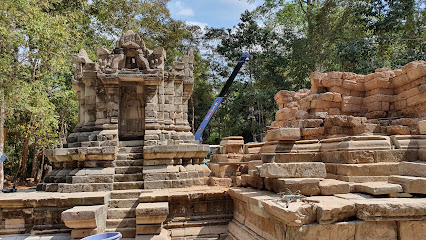Prasat Top West Buddhist Temple, Cambodia

Address
Prasat Top West Buddhist Temple, Krong Siem Reap, Cambodia
Diety
Buddha
Introduction
West Prasat Top is the counterpart for East Prasat Top. They share the same name because they have the same design and are located close to each other. However, the history of the two temples couldn’t be more different. West Prasat Top, also called Prasat Top West or Monument 486, is a small ruined temple tower situated in the tranquil western part of Angkor Thom. It can be reached by taking the forest road (Carpeaux road) to the West Gate. After one kilometer there is a board, here you turn left and reach the site after 300 m.
Puranic Significance
The temple originally consisted of a single Prasat tower on a steep platform; it bears some similarity in appearance to the Mangalartha temple, which is sometimes called East Prasat Top. But it has a rather different history. Inscriptions reveal that the West Prasat Top temple was originally a shrine of a much earlier date. Maybe, it was built as early as the 9th century. An inscription of that Roluos period was found here. Definitely there was a monument at this site already in the tenth century. During the Bayon period, the temple was adapted as a Buddhist sanctuary and seems to have remained to be Buddhist even during the resurgence in the late 13th century. However, the current structure is from the late 13th century, from the post-Bayon period. Some elements are even post-Angkorian, e.g. some remaining carvings are Theravada Buddhist, dating as late as the 17th century. Over the course of this period the laterite platform was refaced with sandstone, the existent sanctuary reconstructed using 10th-century decorative elements (pink sandstone lintels and columns). Two additional towers were erected; one to the north and the other to the south of what then became the central structure. The sandstone platform extending in front of the central tower, along with the statue pedestal built at its western end and scattered roof tile fragments, are all that remain of the Buddhist worship hall (vihear) once standing here, its wooden superstructure having long since perished. As the fundamental ritual act in the appropriation of this ancient site for Theravada Buddhism in the centuries following the transfer of the capital from Angkor, the temple’s sacred terrain was delimited at each of the eight cardinal and intercardinal points by double border stones (seima); though partially buried today, some of these leaf-shaped sculptures can still be seen in their original positions.
Century/Period/Age
17th century CE.
Managed By
UNESCO World Heritage Centre.
Nearest Bus Station
Prasat Top east
Nearest Railway Station
Sisophon Station
Nearest Airport
Siem Reap









